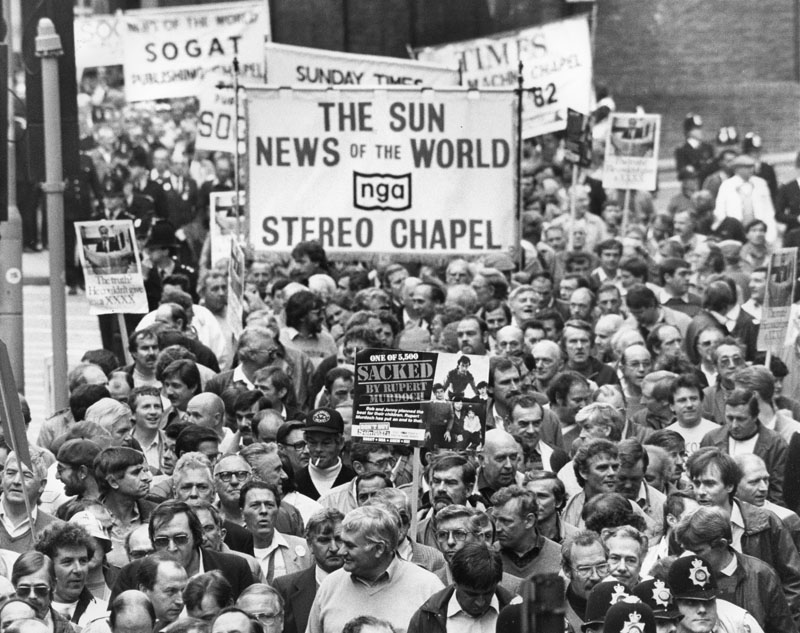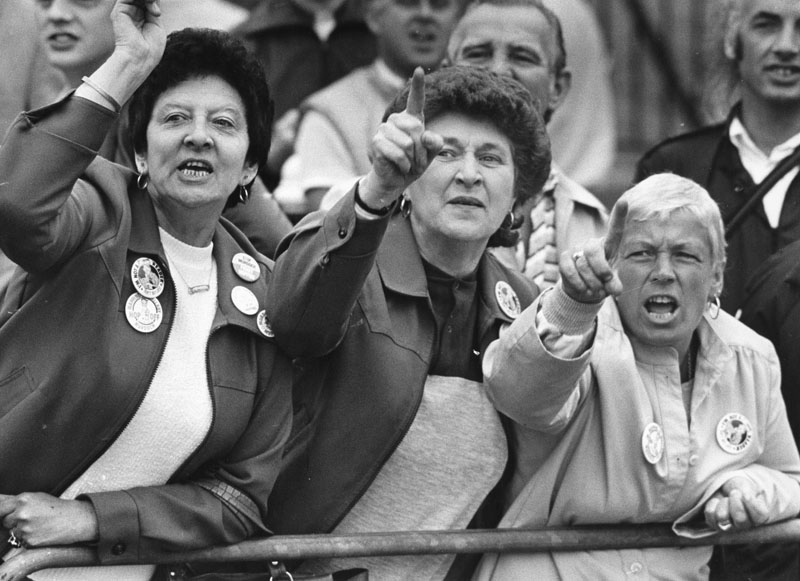The ties that bind
Rupert Murdoch’s plan to set up a new non-union printing works in Wapping was well over a year in the making. It involved Farrers, the Queen’s solicitors and strike busting advice from Christopher Pole Carew – the then actual Sherriff of Nottingham.
Add in a fake newspaper called the London Post – which Rupert swore to a court was “real to me in every way”, and a network of strikebreaking operations bringing in an alternative workforce from Southampton, to Tring, to Australia.
Murdoch also broke distribution contracts with British Rail – that cost him £30m in compensation – and used his own distribution company to get the papers on the shelves.
Underpinning it all were laws which allowed strikers to be sacked on the spot without redundancy payments. And most of all a Thatcher government which supplied a union-busting legal framework and a police force which operated as her storm troopers in industrial disputes.
Murdoch had all he needed – a new printing plant in Wapping, new staff supplied by strike breaking operations, his own distribution network and as much taxpayer funded police security as he wanted.
He had enough UK-based journalists prepared to enter Wapping which he combined with others shipped in from Australia – no visa problem for those economic migrants – to get the papers written, subbed and published.
This was the heady mix which, 30 years ago yesterday (January 24), paved the way for Rupert Murdoch’s four national newspaper titles to make a well planned move to a new site in Wapping. It was typical Murdoch-style – audacious, vicious and profitable.
The move upped his profits across the four titles. The Wapping flit was a very risky move, but it produced enough profit to fund his incredible expansion in media companies across the globe.
Leverage
Without Wapping, without Thatcher and the Tories, Murdoch would not have the global media empire he now commands. Wapping resulted in a Murdoch media empire which gives him political and financial leverage in the UK and elsewhere.
You may hear the move to Wapping was about ‘new technology’ – computerised typesetting and page make up. But at its heart it was never really about technology. The type of technology he started with at Wapping was in use across the provincial press, operated by print union members.
It was really about busting the unions, forcing the unions into a strike so he could sack the staff on the cheap and to ensuring his companies made enough money to expand his family’s media empire across the globe.
I saw this up close and personal, having spent the best part of a year at the strikers’ fortnightly newspaper the Wapping Post. Yes, there were pre-print staff and printers who were sacked and I interviewed them many times.
The conditions they worked in at all four titles were pretty appalling. Many spoke to me of being cheated out of the better physical working conditions at Wapping.
I also saw and spoke to many of the newspaper office workers who were sacked in the move. Newspaper secretaries, librarians, cleaners, drivers, researchers and those who sold the advertising space.
Those who still support what Murdoch did often only speak of the pre-dominantly male printers and their alleged refusal to accept new technology. They skate over Murdoch’s demands for a union-free environment, with management having unfettered rule over the entire workforce.
You could be in a union – it was your right – but the unions would have no say on anything.
And I have never once heard them speak of what technology they thought the – predominantly female – sacked cleaners, secretaries, researchers, librarians and advertising sellers were refusing to use.
Sacking a workforce
Nor how anything justified sacking almost an entire workforce on the cheap by provoking a strike. Farrers, who were also the Queen’s solicitors, gave Murdoch the following accurate – for the time – legal advice in that regard, “The cheapest way would be to dismiss employees while participating in a strike or other industrial action.”
The then Sheriff of Nottingham, Christopher Pole-Carew, who had fought a long battle with the compositors and printers union the National Graphical Association at the Nottingham Evening Post, advised Murdoch’s men to make their move in winter when picketing was cold, wet and in the dark.
So that’s what Murdoch did. Over 5,500 striking print workers, members of the National Graphical Association (NGA) and the Society of Graphical and Allied Trades (Sogat) and the engineers’ union the AEEU were sacked on January 24,1986. No redundancy. Nothing.
Many journalists – some offered lump sums to make the move, others uncertain what to do, made that move. Others – who became known as ‘refuseniks’ – would not move their place of work to Wapping or cross picket lines.
The National Union of Journalists operated an unofficial ‘escape’ committee to help those journalists who initially made the move over the weekend but who then wanted out.
In my year at the Wapping Post I witnessed a one-sided war of attrition. Having taken the risk and made the move, Murdoch had Thatcher’s laws and the Met Police on his side, then under the direct control of the home secretary.
Thatcher’s new legal framework allowed unions to be fined if they broke very restrictive strike laws, some of which are still in place. There were also very real threats to seize union funds – a process known as sequestration.
The National Union of Mineworkers had faced both. In a one year strike between 1984 and 1985 the NUM had all but been destroyed by a Tory government using Tory laws and their willing police storm troopers.
Fortress Wapping
The Wapping plant truly was a fortress which was easy to ‘defend’. The bright lights, surveillance cameras and the fences topped with razor wire had a touch of evil to them.
The whole thing was out of place in what at that time was still a friendly working class area.
There were regular marches, supported by the local residents, the larger ones on Wednesday and Saturday nights. The riot police were brutal time and again and seemed to enjoy what they did.
The City of London police would hand over marches to the Met police when we entered their terrain with the words “we’re handing you over to the animals now.” That was no joke.
On May 3, 1986 I witnessed the worst scenes when police on horseback and police in riot gear charged straight at the crowd which had gathered after the march.
Brute force – both legal and police – won the day in the end. The move to Wapping bound Murdoch very tightly to the Tories (he temporarily switched support when he realised Labour was going to win in 1997).
The Tory ties that bind remain today. It brought the Murdoch-employed Andy Coulson into Downing Street and then to jail.
Even after the phone hacking arrests, the court case and the prison sentences, the Tories remain very close to the Murdoch empire. And Rupert is politically powerful as a result of the Wapping move which supplied the cash for his rapid expansion in the UK and across the globe.
The Tories and Murdoch have shared history of mutual help. A right wing agenda runs through all Murdoch’s newspapers and his political power is summed up in the post-1992 election Sun headline – “It was the Sun wot won it” for the Tories.
And a right wing anti-union, anti-worker approach runs through the reporting of all his UK-based papers. Don’t expect that to change – Labour and the unions are not his friends.
But the Tories and Rupert always new they carried a torch for each other all along.
At the end of Casablanca Humphrey Bogart and Ingrid Bergman knew they always had Paris, so the Tories and Rupert know they will always have Wapping.
Want to find out more? Check out the exhibition around the history of the dispute – on until February 11. Details at:
 Like
Like Follow
Follow

